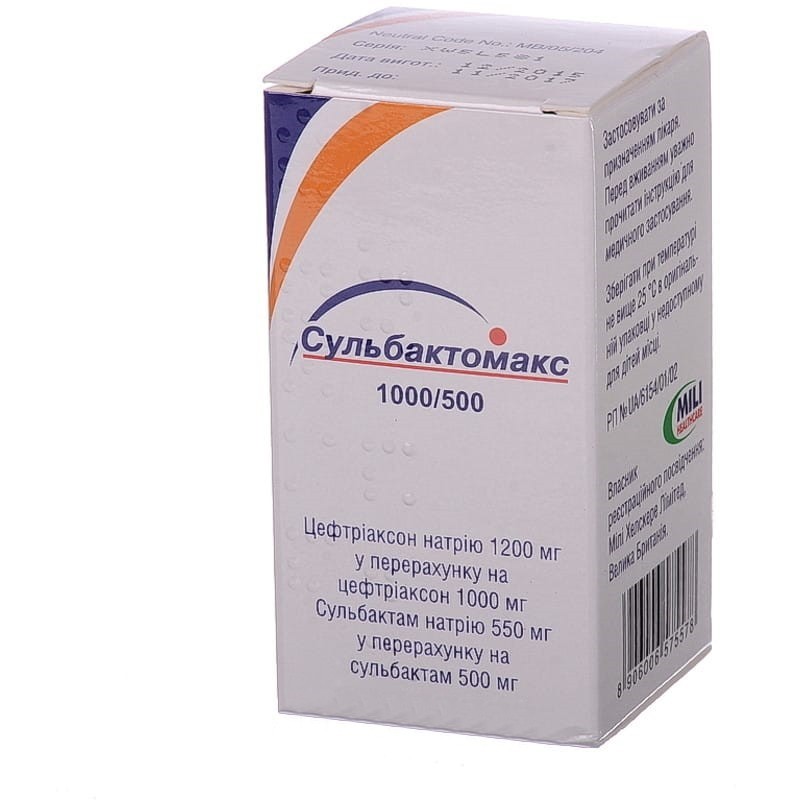



 Secure and encrypted payment processing
Secure and encrypted payment processing We ship to over 40 countries including the USA, UK, Europe, Australia and Japan
We ship to over 40 countries including the USA, UK, Europe, Australia and Japan Guaranteed refund or reship if you haven't received your order
Guaranteed refund or reship if you haven't received your orderSulbactomax is used for the prevention and treatment of lower respiratory tract infections, soft tissue, skin infections, kidney and urinary tract infections, bone and joint infections. With septicemia, infections of the abdominal organs (peritonitis, biliary tract and digestive tract infections) Meningitis, Gonorrhea, Prevention of infections in surgery. Acute bacterial otitis media of the middle ear.
1 vial of 20 ml (1.5 g) contains ceftriaxone (as ceftriaxone sodium) 1000 mg, sulbactam (as sodium sulbactam) 500 mg.
Hypersensitivity to ceftriaxone, or any other cephalosporin. A history of severe hypersensitivity reactions (e.g., anaphylactic reactions) to any other type of beta-lactam antibacterial agents (penicillins, monobactams and carbapenems) history of kidney and / or liver failure, especially ulcerative colitis, enteritis, or with the use of antibacterial drugs. Ceftriaxone is contraindicated in premature infants aged ≤ 41 weeks, taking into account the term of intrauterine development (gestational age + age after birth)
It is applied intravenously or intramuscularly. Before use, skin tests are carried out for sensitivity to antibiotic and lidocaine. Adults and children over 12 years of age 1-2 g (in terms of ceftriaxone) once a day (every 24 hours). In severe cases or infections, the causative agents of which have a reduced sensitivity to ceftriaxone, the daily dose can be increased to 4 g (in terms of ceftriaxone). Newborns, infants and children under 12 years of age. Below are the recommended doses for use once a day. Newborns (up to 14 days). Doses are calculated per ceftriaxone 20-50 mg / kg body weight.
Once a day. The daily dose should not exceed 50 mg / kg body weight. When determining the dose of full-term and premature infants, there are no differences. Ceftriaxone is contraindicated in newborns aged ≤28 days if it is necessary (or the expected need) for treatment with intravenous solutions containing calcium, including continuous intravenous infusions that contain calcium, for example, parenteral nutrition, due to the risk of precipitation of calcium salts of ceftriaxone.
Newborns from the age of 15 days and children up to 12 years. Doses are calculated per ceftriaxone: 20-80 mg / kg body weight 1 time per day. Children with a body weight of more than 50 kg are prescribed doses for adults. The total daily dose for children should not exceed 2 g (in terms of ceftriaxone). Intravenous doses above 50 mg / kg (in terms of ceftriaxone) are administered dropwise (within 30-60 minutes). Elderly patients. Elderly patients do not need dose adjustment. The duration of treatment depends on the course of the disease. After the body temperature indicator is normalized and the test results confirm the absence of the pathogen, it is necessary to continue using the drug for at least 48-72 hours.
To prepare the solution, dissolve the contents of the vial in 40 ml of one of the following infusion solutions that do not contain calcium ions:
Ceftriaxone crosses the placental barrier. Limited data are available on the use of ceftriaxone in pregnant women. Animal studies do not indicate a direct or indirect harmful effect on the embryo / fetus, and postnatal development. During pregnancy, especially in the first trimester, ceftriaxone can be used only if the benefit outweighs the risk.
Ceftriaxone passes into breast milk in low concentrations, but when using the drug in therapeutic doses, no effect on breast infants is expected. However, the risk of developing diarrhea and fungal infection of the mucous membranes cannot be ruled out. The possibility of sensitization should be considered. A decision must be made whether to cease breastfeeding or cease / refuse to use ceftriaxone, taking into account the benefits of breastfeeding for a child and the benefits of therapy for a woman.
Symptoms: There is limited information about overdose cases. In case of an overdose, an increase in the manifestations of adverse reactions is possible.
The drug should not be added to infusion solutions containing calcium, for example, Hartmann or Ringers solution. You should also not apply calcium-containing solutions within 48 hours after the last administration of ceftriaxone. The drug is incompatible with amzacrine, vancomycin, fluconazole and aminoglycosides, antibiotics.
Store at a temperature not exceeding 25 ° C in the original packaging out of the reach of children. Shelf life is 2 years.
Sulbactomax is a combined preparation containing: ceftriaxone (third-generation cephalosporin), which has a wide spectrum of action against sensitive microorganisms in the stage of active multiplication by inhibiting the biosynthesis of mucopeptide cell membranes; sulbactam is an irreversible inhibitor of most of the major beta-lactamases produced by penicillin-resistant microorganisms.